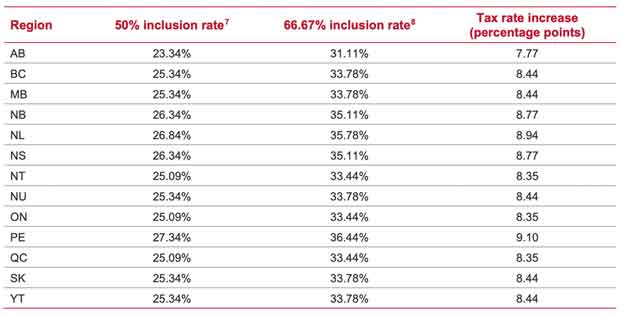Navigating Capital Gains Tax Changes in 2024
Allan Madan, CPA, CA


Starting June 25, 2024, the Government of Canada has increased the capital gains inclusion rate as part of the 2024 Budget. This is a major change to the tax law, the effect of which is that there is a higher capital gains tax on the sale of property, assets, and shares. While the government claims that only the ultra-rich will be impacted, that is simply not true. Many Canadians are impacted by the changes.
In this article, we’ll cover the recent changes, explain how they’ll affect Canadians, outline strategies you can implement, and provide examples to help you understand how these changes may impact you or your business.
What Are The Changes
Before the June 25, 2024 changes, capital gains taxes were calculated based on a ‘one-half inclusion rate.’ This meant that only half of the gain realized on the sale would be taxed. For example, if you sold shares with an accrued gain of $100,000, only $50,000 would be taxed. Whatever amount is included in the capital gain is taxed at your marginal tax rate, which could be as high as 53% if you are a high-income earner.
The new changes are as follows:
- Individuals
- For individuals: two-thirds of capital gains will be taxed, but only if the total capital gains in a year are over $250,000.
- Increased the Lifetime Capital Gains Exemption from $1,000,000 to $1,250,000 for individuals. The LCGE applies to the sale of a business’s qualified shares (i.e. ownership of the business), not to the sale of assets (i.e. your business sells a building).
- Businesses
- For corporations and trusts: two-thirds of any capital gains will be taxed.
- The capital gains tax rate applicable increased from 28.96% to 38.62%.
The Government’s reasoning for these changes is that they intend to“ make the tax system fairer.”[1]
In our opinion, this does not make the tax system fairer. In fact, we believe it will hurt many Canadians who try to build their wealth through means aside from their regular jobs.

Why A Favourable Capital Gains Tax Is Important
A favorable capital gains tax is crucial for promoting economic growth by encouraging individuals and businesses to sell assets, reinvest, and contribute to the economy. Entrepreneurs who pour their time, energy, and resources into building successful businesses are more likely to take risks and innovate when they know they won’t be heavily taxed on the returns from their efforts.
Poor tax policy, on the other hand, discourages investment and entrepreneurship, making it harder for both domestic and international investors to pour money in the Canadian economy. Additionally, with many younger people inheriting second properties and other assets from baby boomers, a reasonable capital gains tax can help them get ahead financially, allowing them to reinvest in new ventures and secure their future. Without those financial upsides, we’ll see younger generations struggle to maintain a high quality of life.
How The Changes Impact Individuals
Capital gains affect individuals that are selling inherited assets, company shares, or rental properties. It does not apply to an individual’s primary residence, as that is not considered a taxable capital gain. The main reason the tax change affects individuals – and not just the ‘ultra-rich’ – is because the sale of their assets often involves real estate, which is rarely listed below the threshold of $250,000.
Here are some examples of how capital gains are calculated:
Sale of Inherited Assets
Bob’s father passes away. Bob inherits a farm from his father worth $2,000,000 based on an appraisal made by a certified appraiser. Bob sells the farm for $3,000,000 three years later.
Capital Gain = $3,000,000 – $2,000,000 = $1,000,000
Sale of Company Shares
Frank sells Apple Stock for $750,000. He purchased the shares for $300,000.
Capital Gain = $750,000 – $300,000 = $450,000
Sale of Rental Property
Anne purchased a rental property for $200,000. She sold the rental property for $600,000 five years later.
Capital Gain = $600,000 – $200,000 = $400,000
Example: Sale Of A Rental Property
Anne sells her rental property and realizes a capital gain of $400,000. That means Anne will include 50% of $250,000 (one-half) and 67% (two-thirds) of the remaining $150,000 in her income as the capital gain. Based on the chart below, Anne will pay a capital gains tax under the new rules for $119,250.
| Below Threshold | Above Threshold | Total | |
| Gain | $250,000 | $150,000 | $400,000 |
| Inclusion Rate | 50% | 67% | |
| Amount Included | $125,000 | $100,000 | $225,000 |
| Tax Payable (53%) | $66,250 | $53,000 | $119,250 |
| Effective Rate | 26.5% | 35.7% |
Under the new rules, the capital gains tax rate has effectively increased from 26.5% to 35.7% on gains over $250,000 which is an increase of 9.2%.
Example: Sale of a Business
Joey sells the shares of his hardware store in Toronto for $1,500,000. He can claim the lifetime capital gains exemption of $1,250,000. After the exemption, the capital gains are $250,000 ($1,500,000 – $1,250,000).
| Below Threshold | Above Threshold | Total | |
| Gain | $1,250,000 | $250,000 | $1,500,000 |
| Inclusion Rate | 0% | 50% | |
| Amount Included | $0 | $125,000 | $125,000 |
| Tax Payable (53%) | $0 | $66,250 | $66,250 |
| Effective Rate | 0% | 26.5% |
Under the new rules, the capital gains tax rate has decreased because $1,250,000 of gains from selling qualified small business corporation shares are exempt. Before the new rules came into effect the exemption amount was lower, $1,000,000
How The Changes Impact Businesses
Capital gains in relation to businesses can include the sale of assets such as buildings or land, equipment, stocks, and investments. The changes in capital gains tax rates vary by province and are as follows:

Example: Sale of Corporate Asset
Bob owns ABC Inc., a corporation in the garment industry based in Ontario. Suppose ABC Inc. sold its Warehouse for a profit of $100,000. How much is the total tax payable by the corporation and by Bob on the cash distributions he receives from the sale? The total tax payable is $38,620 and Bob is left with after-tax cash of $61,380.
| Profit from the sale of Warehouse | $100,000 |
| Capital Gains Tax (Personal + Corporate) | ($38,620) |
| After-Tax Cash Available to Bob | $61,380 |
Capital Gains Strategy
Given the recent changes to the capital gains tax laws, careful planning has become even more important. Here are three strategies to help reduce your capital gains tax burden under the new rules:
- Gradual Asset Sales: One of the most effective ways to minimize your personal capital gains tax is to spread out the sale of assets or shares over multiple years. By doing so, you can keep the total gains in any given year below the $250,000 threshold. This gradual approach can be particularly beneficial for individuals with substantial assets who would otherwise face a significant tax hit.
- Using a Family Trust: Establishing a family trust is another smart way to reduce capital gains taxes. A family trust allows you to split capital gains among several family members, each of whom can take advantage of their individual $250,000 threshold at the 50% inclusion rate. By allocating gains to family members in lower tax brackets, the overall tax liability is reduced, providing a more tax-efficient way to manage gains from asset sales.
- Focus on Individual Capital Gains: For business owners, it may be more advantageous to purchase stocks or other investments personally, rather than through the business. When you hold investments personally, any capital losses you incur can be applied directly to your individual capital gains, offering more flexibility in managing taxes. You’ll need to consider the overall financial goals of your business versus your personal wealth accumulation when making investment decisions.
- Applying Capital Losses: Finally, if you’ve experienced capital losses in the past or expect them in the future, it’s crucial to apply them strategically to offset gains that are taxed at the higher inclusion rate of 66.7%. Since capital losses can be carried forward indefinitely, they can be an invaluable tool in managing tax liability.
By using these strategies, you can minimize your exposure to the higher tax rates and optimize your capital gains planning under the new laws. If you have any questions about these new laws or want help with your tax strategy, reach out to our team by clicking here.
[1] Source: https://www.canada.ca/en/department-finance/news/2024/06/capital-gains-inclusion-rate.html
[2] Source: https://www.cibc.com/content/dam/personal_banking/advice_centre/tax-savings/capital-gains-planning-en.pdf
Disclaimer
The information provided on this page is intended to provide general information. The information does not take into account your personal situation and is not intended to be used without consultation from accounting and financial professionals. Allan Madan and Madan Chartered Accountant will not be held liable for any problems that arise from the usage of the information provided on this page.



